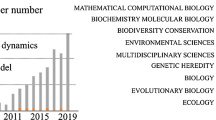Abstract
The paper considers the properties of individual life history corresponding to the Leslie model of age-structured population. The life history is modelled as a finite Markov chain with absorption at a death state of individual. In this model, individual longevity, average number of offspring R L (produced by an individual over the entire life), and some other known characteristics of the life history have been derived using simple probability methods that do not involve matrix calculus and their individual components have been interpreted. In the linear Leslie population model (derived by simple modification of a Markov chain), R L determines the growth or decline of a population. Individuals with higher R L values have evolutionary advantages in the population due to accelerated growth in their number. The selection of fertility as a factor of the increase in R L is considered. In the Leslie model, fertility is a set of correlated quantitative traits, where the age-specific fertility components are determined both by multiple loci and the environment. According to the genetic theory of quantitative trait selection, they evolve towards an increase in R L . Taking into account the limited resources for reproduction, selection optimizes the fertility distribution according to age. Optimal distribution corresponds to the attainment of the maximum R L . This complies with the maximization of the rate of population growth (r-selection), which is characteristic of linear population models. The search for the R L maximum and optimal distribution of fertility belongs to the field of linear programming.
Similar content being viewed by others
References
Rashevsky, N., Models and Mathematical Principles in Biology, in Theoretical and Mathematical Biology, New York: Blaisdell, 1965, pp. 36–53.
Rosen, R., Optimality Principles in Biology, London: Butterworths, 1967.
McNamara, J.M., Houston, A.J., and Collins, E.J., Optimality Models in Behavioral Biology, SIAM Rev., 2001, vol. 43, no. 3, pp. 413–466.
Leslie, P.H., On the Use of Matrices in Certain Population Mathematics, Biometrika, 1945, vol. 33, no. 3, pp. 183–212.
Kemeni, J.G. and Snell, J.L., Finite Markov Chains, Princeton: Van Nostrand, 1960.
Keyfitz, N. and Caswell, H., Applied Mathematical Demography, New York: Springer-Verlag, 2005, 3rd ed.
Cushing, J.M. and Yicang, Z., The Net Reproductive Value and Stability in Matrix Population Models, Nat. Resour. Model., 1994, vol. 8, no. 4, pp. 297–333.
Logofet, D.O. and Belova, I.N., Nonnegative Matrices as a Tool to Model Population Dynamics: Classical Models and Contemporary Expansions, Fundam. Prikl. Mat., 2007, vol. 13, no. 4, pp. 145–164.
Gimel’farb, A.A., Ginzburg, L.R., Poluektov, R.A., et al., Dinamicheskaya teoriya biologicheskikh populyatsii (Dynamic Theory of Biological Population), Moscow: Nauka, 1974.
Budilova, E.V. and Terekhin, A.T., Mathematical Modeling of Life History Evolution: A Brief History and Main Trends, Zh. Obshch. Biol., 2010, vol. 71, no. 4, pp. 275–286.
Stearns, S.C., Life History Evolution: Successes, Limitations, and Prospects, Naturwissenschaften, 2000, vol. 87, no. 11, pp. 476–486.
Lande, R., Natural Selection and Random Genetic Drift in Phenotypic Evolution, Evolution, 1976, vol. 30, no. 2, pp. 314–334.
Lande, R. and Arnold, S.J., The Measurement of Selection on Correlated Characters, Evolution, 1983, vol. 37, no. 6, pp. 1210–1226.
Lande, R., A Quantitative Genetic Theory of Life History Evolution, Ecology, 1982, vol. 63, no. 3, pp. 607–615.
Passekov, V.P., Asymptotic Analysis of Selection in a Multilocus, Multiallelic Population, Dokl. Akad. Nauk SSSR, 1984, vol. 277, no. 6, pp. 1338–1341.
Nagylaki, T., The Evolution of Multilocus Systems under Weak Selection, Genetics, 1995, vol. 134, no. 2, pp. 627–647.
Passekov, V.P., On Fisher’s Fundamental Theorem of Natural Selection for Space-Structured Populations under the Conditions of Strong Migration, Dokl. Akad. Nauk, 2007, vol. 412, no. 1, pp. 35–39.
Passekov, V.P., On the Problems of Evolutionary Optimization of Life History. II. To the Justification of Optimization Criterion for Nonlinear Leslie Model, Russ. J. Genet., 2013, vol. 49 (see present issue pp. 400–409).
Venttsel’, E.S., Issledovanie operatsii: zadachi, printsipy, metodologiya (The Study of Operation: Goals, Principles, and Methodology), Moscow: Nauka, 1988.
Ashmanov, S.A., Lineinoe programmirovanie (Linear Programming), Moscow: Nauka, 1981.
Pianka, E.R., Evolutionary Ecology, New York: Harper and Row, 1978, 2nd ed.
Author information
Authors and Affiliations
Corresponding author
Additional information
Original Russian Text © V.P. Passekov, 2013, published in Genetika, 2013, Vol. 49, No. 3, pp. 392–399.
Rights and permissions
About this article
Cite this article
Passekov, V.P. On the problems of the evolutionary optimization of life history. I. Markov model of Leslie life cycle and optimization of fertility. Russ J Genet 49, 344–350 (2013). https://doi.org/10.1134/S1022795413030125
Received:
Published:
Issue Date:
DOI: https://doi.org/10.1134/S1022795413030125



